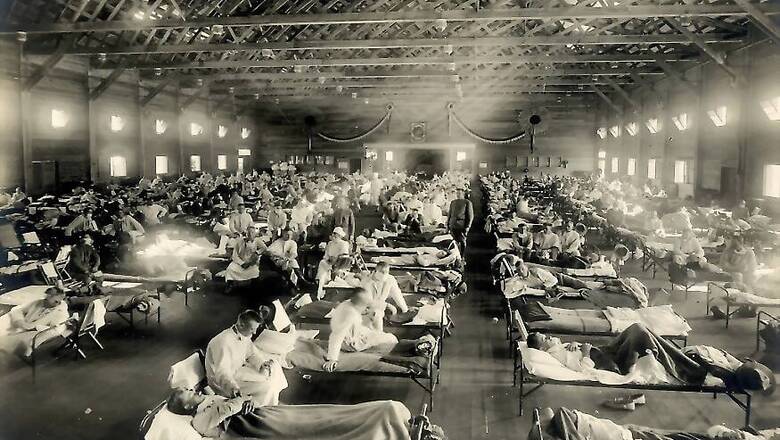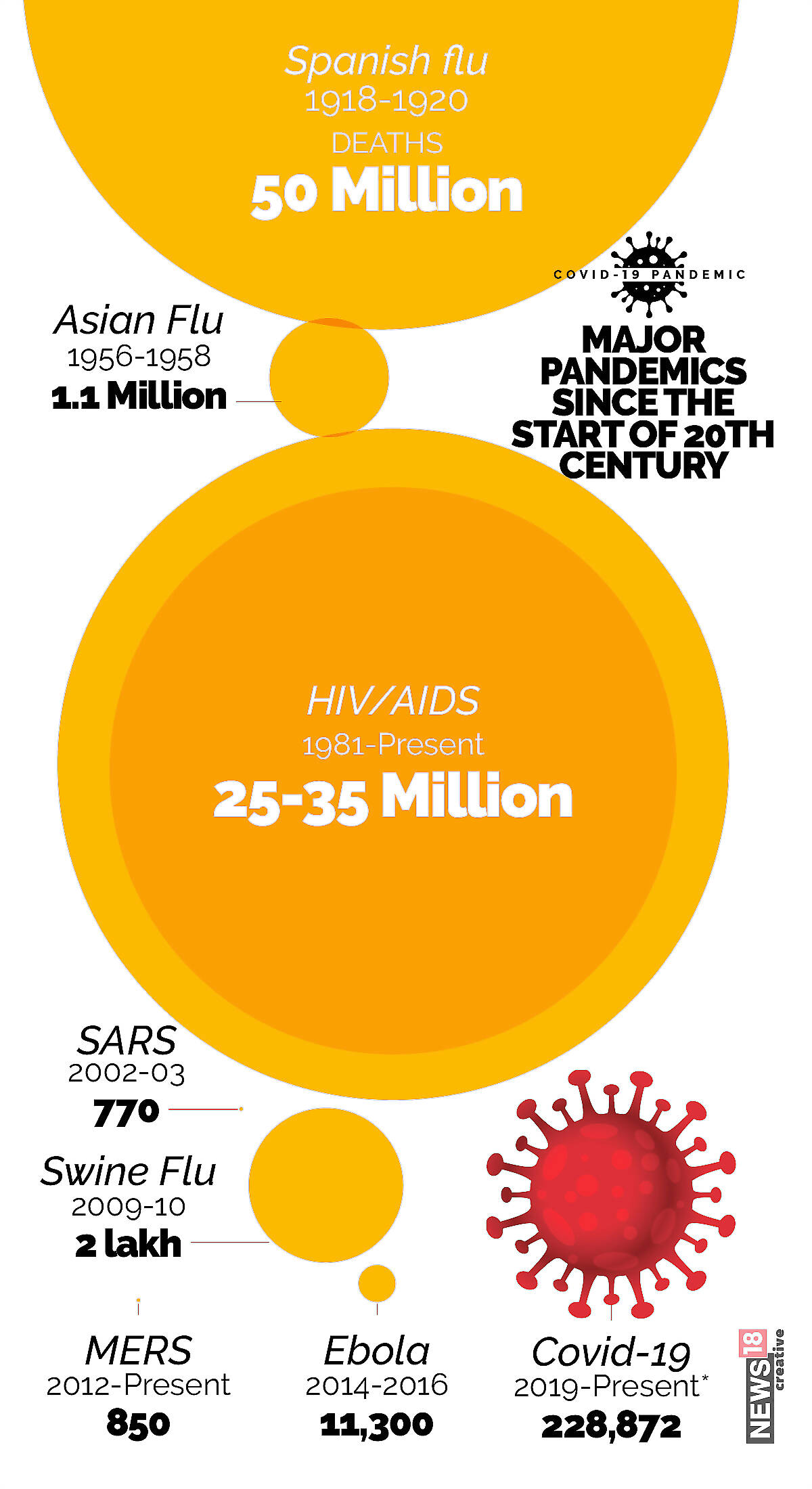
views
The human race has been devastated by several natural disasters like volcanoes, earthquakes and floods. There have been countless wars that have led to countless deaths. But throughout history, nothing has taken more human lives than the pandemics caused by viruses, bacteria and parasites.
1. The Plague of Justinian: Caused by the bacterium, Yersinia Pestis, the Plague of Justinian killed as many as 50 million people in the 6th Century and changed the course of history by massively weakening the Byzantine Empire. The death of farmers in an agrarian economy resulted in shortage of food and loss of revenue from taxes on landholdings.
2. The Black Death: So far, it is the most fatal pandemic in human history accounting for 200 million deaths across Eurasia and North Africa. The Black Death peaked in Europe from 1347 to 1351 and was again caused by bacterium Yersenia Pestis wiping out around 45% of Europe’s population. It took 200 years for the Continent to recover to its previous level and led to colossal social-economic upheaval. Some historians believe the innumerable deaths brought the temperatures down by freeing up land and led to the Little Ice Age. It is also believed to have led to the Renaissance in Italy in the late 14th Century.
3. The Great Plague of London: Nearly 2 lakh people were killed in the Great Plague of London in the city (one-fourth of London’s population) in just 7 months between 1665 to 1666.
4. The Smallpox Virus: Besides killing millions of native inhabitants of the Aztec Empire (now Mexico) between 1520 to 1527, the smallpox virus also severely weakened the Incan Empire. It then ravaged North-East America wiping out 90% of the Native Americans. There were several other outbreaks of the virus in the new world. Smallpox is estimated to have killed 4 lakh people per year in 18th Century Europe with one-third of the people turning blind.
Even after Edward Jenner developed the first smallpox vaccine in 1798 and the modern version emerged in the 19th century, around 300 million people died of the virus in the 20th century. From 1958 to 1977, the WHO conducted a global vaccination campaign and in 1980 the World Health Assembly endorsed the eradication of the deadly virus. It became the only human virus to have been eradicated from the world. In the absence of a vaccine, between 1980 and 2018, some 200 million lives could have been lost to smallpox.
Smallpox was used as a biological warfare weapon by the British during the French and Indian Wars in the middle of the 18th Century. Scientists from the United Kingdom, United States and Japan were involved in a research to produce a biological weapon from smallpox during World War 2 only to shelf the plan in the wake of an available vaccine.
5. Cholera: In India, the first Cholera pandemic occurred in the Bengal region between 1817-1824. Some 15 million people have been estimated to have died during the first three Cholera pandemics in India by 1860.The sixth Cholera outbreak began in India in 1899 and killed more than 8 lakh people. Major scientific breakthroughs towards the treatment of this bacterial disease were made between 1879-1883 and the first vaccine was developed in 1892 by the Russian-Jewish bacteriologist, Waldemar Haffkine.
The seventh Cholera outbreak started in Indonesia in 1961 and by 1966, it had affected most of Asia. In 2016, the FDA approved Vaxchora – a single-dose oral vaccine to prevent Cholera.
6. Plague: The third plague pandemic (after the Plague of Justinian and Black Death) outbreak started in Yunnam, China in 1855 during the Qing dynasty and led to more than 12 million deaths in India and China.
Overall, the three Plague pandemics have killed nearly 200 million people and although there are antibiotics that can cure the disease if the treatment is prompt, till date there is no licensed vaccine for the disease. There was a vaccine that protected against Bubonic Plague but did not prevent Pneumonic Plague and was discontinued.
The Great Pandemics Since the 20th Century

THE SPANISH FLU (1918-20)
The Spanish Flu was caused by an unusually deadly HINI Influenza virus and infected about 500 million (one-third of the world's population at the time), wiping out close to 50 million people. It is the deadliest pandemic since the start of the 20th Century and reported more deaths than World War 1 (1914-1918). Some 14 million people died in India – around 5% of the population – it was the worst affected nation in terms of mortality. The Flu surprisingly had a high mortality rate in a lot of young adults (age-group 20-40) and was severe in the summer and autumn in the Northern Hemisphere.
The Flu became less deadly after the second wave in October, 1918. Some virologists believe that the virus mutated rapidly to a less lethal strain as is common with Influenza viruses.
Some historians argue that the virus shifted the balance of power towards the Allied Forces towards the end of World War 1 as the Flu initially struck the Central Powers. Healthcare systems improved around the world and there was a rapid rise of women in the field of medical nursing.
The World Bank estimated a total social and economic loss of $4 billion as a result of the Spanish Flu.
India’s GDP declined by 12.8% in 1918.
In 2008, researchers discovered the reason that the made the 1918 flu so deadly – a group of three genes enabled the virus to weaken a victim’s bronchial tubes and lungs making way for bacterial pneumonia.
THE ASIAN FLU (1956-58)
The Asian Flu was a global pandemic of Influenza A Virus Subtype H2N2, which originated in Guizhou, China and soon spread to Hong Kong, Singapore, Taiwan, India, United Kingdom and finally the United States. It killed about 1.1 million people worldwide with around 1 lakh deaths in the United States. The figure would have been much higher if not for Dr Maurice Hilleman who had already prepared a vaccine for the flu before it arrived in America.
The Dow Jones Industrial Average lost 15% of its value in 1957. The economic and social loss of the Asian Flu is estimated at $ 9 billion.
HIV/AIDS (1981-Present)
The first cases of the Acquired Immunodeficiency Syndrome (AIDS) were reported in 1981 and since then the infection with Human Immunodeficiency Virus (HIV) has grown to pandemic proportions. It has resulted in an estimated 35 million deaths worldwide. Currently, there are around 32 million people living with HIV with 21 million in Sub-Saharan Africa.
AIDS-related deaths have been reduced by more than 55% since the peak in 2004. In 2018, around 7,70,000 people died from AIDS-related illnesses worldwide, compared to 1.2 million in 2010 and 1.7 million in 2004.
There is still no vaccine for AIDS but antiretroviral treatments allow people to control its progression and live normal life spans. A experimental vaccine prevented about 31 percent of new cases but was stopped due to severe risks, revealed a study in 2009. Currently, clinical trials are underway at the University of Pittsburgh for a potential breakthrough vaccine.
SARS (2002-03)
The Severe Acute Respiratory Syndrome Coronavirus (SARS-CoV) was identified in 2003 and is believed to be a virus that spread to civet cats from bats and infected humans in the Guangdong province of Southern China in 2002. It spread to 26 countries and resulted in 8000 cases and 770 deaths in 2003. China and Hong Kong were the most severely affected with 349 and 299 deaths. SARS had a very high mortality rate of 9.6%.
The social and economic cost of SARS is estimated to be around $ 40 billion. It had an adverse effect on some sectors (retail sales, hotels, air industry, tourism) of certain East Asian and the Canadian economies. Currently, there is no vaccine, treatment or cure but antiviral medications and steroids do work for some patients.
SWINE FLU (2009-10)
The 2009 Swine Flu was the second of the two pandemics caused by the HINI Influenza Virus (after the 1918 Spanish Flu). It originated in Mexico before spreading to the rest of the world. The number of confirmed cases was 1.6 million although some studies put the estimate at 6.7 million. The number of deaths range between 1,50,000 and 3,00,000. The USA, Brazil, India and Mexico reported the maximum number of lab-confirmed deaths.
By November, 2009, however, doses of vaccine had been administered in 16 countries. Oseltamivir and Zanamivir are the two antiviral drugs recommended for treating Swine Flu.
The estimated loss due to Swine Flu is around $50 billion with 0.6% negative impact on the GDP of South Asia.
MERS (2012-Present)
The Middle East Respiratory Syndrome, popularly known as Camel Flu, is a viral infection caused by the MERS-Coronavirus. The first case was reported from Saudi Arabia in 2012 and so far a total of 2,506 people have contracted the virus and 850 have died from it – which makes the mortality rate of 34% very high. Most of the cases have been reported in the Arabian Peninsula and so far there is no vaccine for the virus. South Korea also reported an outbreak in 2015 which led to the death of 36 people in the country. The estimated economic and social loss is at $ 10 billion.
EBOLA (2014-16)
The Ebola Virus disease is transmitted through wild animals such as fruit bats and porcupine and has a very high mortality rate of 50%. The 2014-16 outbreak in West Africa infected around 28,000 people and led to 11,323 deaths. An Ebola vaccine, rVSV-Zebov was approved in the USA in 2019 and more than 1 lakh people have benefitted from it.
The Ebola pandemic ravaged the economies of Guinea, Liberia and Sierra Leone and an estimated $2.2 billion were lost in 2015 in the GDP of the three countries.
The Covid-19 (SARS COV-2) has already affected 186 countries with 3.2 million cases and 2,28,872 deaths.
With most of the countries planning to lift their stringent lockdowns and restart their economic engines in the coming weeks, strategic shutdowns, social distancing and isolation and herd immunity coupled with treatment for the elderly and vulnerable are the only practical ways to move forward.
Although a lot of treatments have shown promise, there is no cure or definitively proposed vaccine yet for COVID-19.
Meanwhile, the estimated economic loss to the world due to the slowdown in the global economy is predicted to be around $1 trillion and up to half a billion or 8% of the global population could further be forced into poverty. Europe is certain to go into recession while there is bound to be a major shift in the global order with China taking the mantle from the USA. This could further lead to an increasingly polarised world.
Developing countries like India already reeling with high levels of inequalities, poverty and unemployment, will have to balance the act of saving lives and livelihoods as the virus is here to stay. At least for the time being.















Comments
0 comment